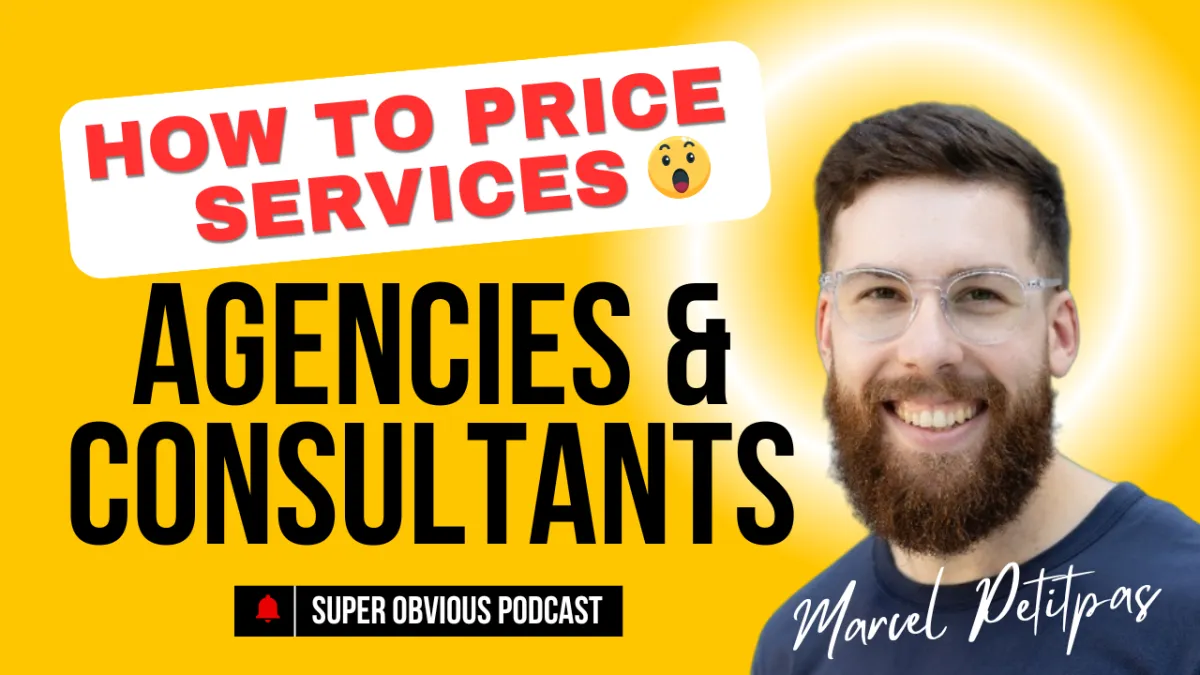
How do you Price a Service if you're a Consultant or Agency Owner?
Pricing your services correctly is one of the biggest challenges for consultants and agency owners. Price too high, and you risk losing potential clients. Price too low, and you’ll overwork yourself while struggling to stay profitable.
In this episode, I sit down with Marcel Petitpas (Parakeeto) to break down:
The biggest mistakes consultants and agencies make when pricing services
The four proven pricing models and when to use them
A step-by-step formula to set prices that maximize profitability
How to avoid scope creep and ensure healthy margins
By the end of this article, you’ll have a clear strategy to price your services confidently and profitably.
For additional insights:
Common Pricing Mistakes (And Why They Hurt Your Profits)
Before we dive into the right approach, let’s look at the most common pricing mistakes that consultants and agencies make:
1. Pricing Based on Competitor Rates
Many businesses simply copy what others charge without considering their own costs, margins, or value. This leads to:
Unpredictable profitability
Charging too little (or too much) for the value you provide
No clear differentiation in the market
For a detailed breakdown of pricing strategies, Forbes offers a guide on pricing consulting services.
2. Tying Price to Hours Instead of Outcomes
Billing purely by the hour often:
Caps your income (since there are only so many hours in a day)
Puts price sensitivity on your time rather than your expertise
Encourages clients to focus on cost rather than results
3. Not Knowing Your Profit Margins
Many consultants and agencies price their services without knowing how much profit they’ll actually make. If you don’t calculate your delivery cost and target margin, you could be losing money on every project.
To understand profitability better, McKinsey & Company provides an analysis of pricing professional services.
4. Not Adjusting for Risk or Complexity
Projects with high uncertainty require more time, expertise, and risk management. If you don’t factor this into your pricing, you’ll:
Underestimate project scope
Over-service clients without being paid for it
Burn out your team or yourself
The Four Proven Pricing Models for Consultants and Agencies
Now that we’ve covered the mistakes, let’s talk about the right way to price your services. The best approach depends on value, risk, and scope of work.
For a detailed comparison of agency pricing models, see HubSpot’s guide on pricing structures.
1. Hourly Pricing (Best for Uncertain, Short-Term Work)
How it works: Charge a fixed hourly rate for your time.
When to use it:
When the scope is unclear (e.g., consulting calls, advisory work)
When clients need flexibility (e.g., retainers with variable hours)
When projects involve high risk and uncertainty
Pros:
Simple to implement
Works well for short-term engagements
Cons:
Limits earning potential (time equals money)
Creates pricing resistance from clients who want cost certainty
2. Flat-Fee or Project-Based Pricing (Best for Repeatable Services)
How it works: Set a fixed price for a defined service or project.
When to use it:
When the scope is predictable (e.g., branding packages, website design)
When you have clear deliverables
When you can automate or productize parts of your service
Pros:
Easier to sell (clients prefer predictable costs)
Allows you to improve margins by working efficiently
Cons:
Can lead to scope creep if not carefully managed
Requires accurate cost estimation to remain profitable
For more insight into fixed-fee pricing, QuickBooks explains how to price service-based businesses.
3. Retainer Pricing (Best for Ongoing Services and Long-Term Clients)
How it works: Clients pay a monthly recurring fee for a set amount of work or deliverables.
When to use it:
When providing ongoing services (e.g., SEO, content marketing, consulting)
When working with long-term clients
When you want predictable cash flow
Pros:
Creates consistent revenue
Strengthens client relationships
Reduces the need for constant sales and new client acquisition
Cons:
Clients may question value over time
Requires clear boundaries to prevent over-servicing
4. Value-Based Pricing (Best for High-Impact, High-ROI Services)
How it works: Charge based on the value you create for the client rather than time or deliverables.
When to use it:
When you can directly link your service to revenue growth (e.g., conversion optimization, sales training)
When the client stands to gain significantly more than your fee
When you have a proven, repeatable process
Pros:
Maximizes profit potential
Aligns price with the value delivered
Cons:
Harder to sell and justify without strong proof
Requires detailed client discovery and ROI tracking
For a deeper look at value-based pricing, ProfitWell explains the difference between value-based and hourly pricing.
How to Price Your Services Step-by-Step
Step 1: Define Your Delivery Cost and Target Profit Margin
Use the Margin-First Pricing Formula:
Price = Delivery Cost ÷ (1 - Target Margin) + Pass-Through Expenses
Step 2: Choose the Right Pricing Model
Short-term or unpredictable scope? → Hourly rate
Fixed-scope, repeatable work? → Flat-fee project pricing
Ongoing services? → Retainers
High ROI impact? → Value-based pricing
Step 3: Set Minimum Pricing Floors
Never price below your profitability threshold. Use a pricing calculator to validate.
Step 4: Factor in Risk and Complexity
Increase prices for:
Unique, custom work
High uncertainty projects
Fast turnarounds or rush jobs
Step 5: Test, Adjust, and Optimize
Pricing is not static. Test different models, track profitability per project, and refine your approach over time.
Final Thoughts: Pricing for Profit and Growth
By following this guide, you can:
Avoid underpricing and over-servicing
Choose the right pricing model for each situation
Ensure healthy margins and predictable revenue
For additional insights:
